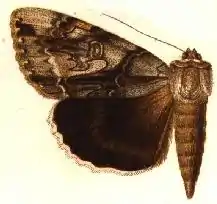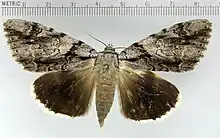| Widow underwing | |
|---|---|
 | |
.jpg.webp) | |
| Scientific classification | |
| Domain: | Eukaryota |
| Kingdom: | Animalia |
| Phylum: | Arthropoda |
| Class: | Insecta |
| Order: | Lepidoptera |
| Superfamily: | Noctuoidea |
| Family: | Erebidae |
| Genus: | Catocala |
| Species: | C. vidua |
| Binomial name | |
| Catocala vidua (J. E. Smith, 1797) | |
| Synonyms | |
| |
Catocala vidua, the widow underwing, is a moth of the family Erebidae. The species was first described by James Edward Smith in 1797.[1][2] It is found in North America from southern Ontario, into Maine, New Hampshire and Connecticut, south at least to Tennessee, Georgia and Alabama, west to Texas and Oklahoma, and north to Wisconsin.
The wingspan is 70–80 mm. Adults are on wing from August to October. There is one generation per year.

The larvae feed on Carya illinoinensis, Carya ovata, Carya pallida, Juglans cinerea, Juglans nigra, Quercus, Robinia pseudoacacia, and Salix.
References
Wikimedia Commons has media related to Catocala vidua.
Wikispecies has information related to Catocala vidua.
- ↑ Yu, Dicky Sick Ki. "Catocala vidua (Smith 1797)". Home of Ichneumonoidea. Taxapad. Archived from the original on March 15, 2016.
- ↑ Savela, Markku (July 27, 2019). "Catocala vidua (Smith, 1797)". Lepidoptera and Some Other Life Forms. Retrieved October 23, 2019.
External links
- Oehlke, Bill. "Catocala vidua (J.E. Smith, 1797) Phalaena vidua". The Catocala Website. Archived April 5, 2012.
This article is issued from Wikipedia. The text is licensed under Creative Commons - Attribution - Sharealike. Additional terms may apply for the media files.